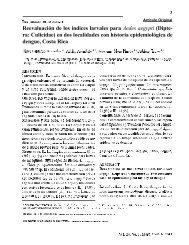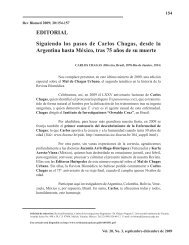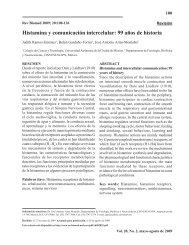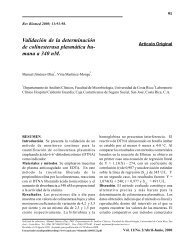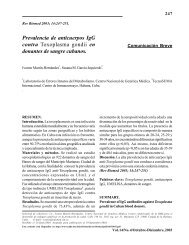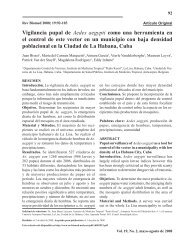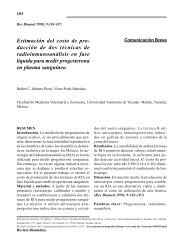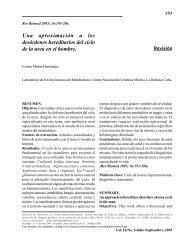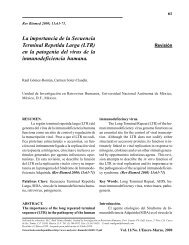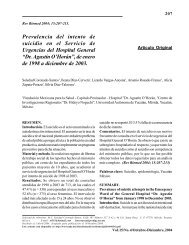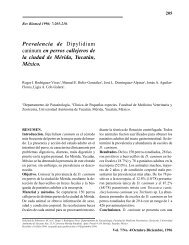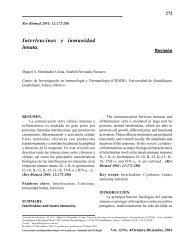Plantas de la flora yucatanense que provocan alguna toxicidad en ...
Plantas de la flora yucatanense que provocan alguna toxicidad en ...
Plantas de la flora yucatanense que provocan alguna toxicidad en ...
You also want an ePaper? Increase the reach of your titles
YUMPU automatically turns print PDFs into web optimized ePapers that Google loves.
87<br />
JS Flores, GCO Canto-Aviles, AG Flores-Serrano.<br />
toxicity in the human being. It m<strong>en</strong>tions their<br />
species, their family, their common name, the part<br />
of the p<strong>la</strong>nt that causes toxicity, their distribution<br />
in the P<strong>en</strong>insu<strong>la</strong>, their intoxication effects and the<br />
type of vegetation where they are located.<br />
Material and methods. To obtain the<br />
information, the Etno<strong>flora</strong> Yucatan<strong>en</strong>sis Programa<br />
from the Faculty of Veterinary Medicine and<br />
Husbandry data bases were revised; interviews in<br />
hospitals, clinics and the Red Cross hospital were<br />
carried out, especially in Merida city, with the<br />
objective of <strong>de</strong>tecting applied the cases of pati<strong>en</strong>ts<br />
treated for p<strong>la</strong>nt intoxication. Interviews were also<br />
to "H'm<strong>en</strong>es" and 25 adults in 25 mayan<br />
communities, a total of 300 interviews were ma<strong>de</strong>.<br />
Results. The toxic p<strong>la</strong>nts were collected and<br />
herborized at the herbarium of the Autonomous<br />
University of Yucatan. In total, information from<br />
50 species corresponding to 17 families was<br />
obtained; it was found that 23 (46%) were also<br />
ornam<strong>en</strong>tal p<strong>la</strong>nts.<br />
Conclusions. The main reason to know these<br />
p<strong>la</strong>nts in or<strong>de</strong>r to avoid them, since some of them<br />
can ev<strong>en</strong> cause <strong>de</strong>ath.<br />
(Rev Biomed 2001; 12:86-96)<br />
Key words: Toxic p<strong>la</strong>nts for humans,<br />
yucatan<strong>en</strong>sis <strong>flora</strong>.<br />
INTRODUCCIÓN.<br />
El conocimi<strong>en</strong>to <strong>de</strong>l recurso vegetal ha sido<br />
una meta <strong>de</strong>l hombre <strong>de</strong>s<strong>de</strong> <strong>que</strong> éste aparece <strong>en</strong><br />
<strong>la</strong> esca<strong>la</strong> zoológica; así <strong>la</strong> re<strong>la</strong>ción p<strong>la</strong>nta-hombre<br />
es tan antigua como este mismo. Dicha re<strong>la</strong>ción<br />
es notable por <strong>la</strong> gran diversidad <strong>de</strong> usos <strong>que</strong> han<br />
sido reve<strong>la</strong>dos a través <strong>de</strong> los estudios<br />
etnobotánicos, como por ejemplo: alim<strong>en</strong>to,<br />
medicina, <strong>de</strong>f<strong>en</strong>sa, construcción, vestido,<br />
colorante y forrajes. Sin embargo <strong>la</strong>s p<strong>la</strong>ntas<br />
también pue<strong>de</strong>n cont<strong>en</strong>er sustancias nocivas <strong>que</strong><br />
pue<strong>de</strong>n ocasionar trastornos al ser humano, los<br />
cuales van <strong>de</strong>s<strong>de</strong> irritaciones, comezón y<br />
<strong>que</strong>maduras <strong>en</strong> <strong>la</strong> piel, hasta vómitos, diarreas, e<br />
Revista Biomédica<br />
incluso <strong>la</strong> muerte. Se les l<strong>la</strong>ma p<strong>la</strong>ntas tóxicas a<br />
a<strong>que</strong>l<strong>la</strong>s <strong>que</strong> conti<strong>en</strong><strong>en</strong> <strong>alguna</strong> sustancia química<br />
capaz <strong>de</strong> producir algún tipo <strong>de</strong> trastorno a <strong>la</strong><br />
salud <strong>de</strong>l ser humano.<br />
Debido a <strong>que</strong> se ha observado <strong>que</strong> <strong>alguna</strong>s<br />
<strong>de</strong> <strong>la</strong>s p<strong>la</strong>ntas <strong>de</strong> uso común <strong>en</strong> <strong>la</strong> pob<strong>la</strong>ción son<br />
p<strong>la</strong>ntas tóxicas, consi<strong>de</strong>ramos <strong>que</strong> es <strong>de</strong> suma<br />
importancia el t<strong>en</strong>er un conocimi<strong>en</strong>to <strong>de</strong>tal<strong>la</strong>do<br />
<strong>de</strong> cuáles son estas p<strong>la</strong>ntas y su distribución <strong>en</strong> <strong>la</strong><br />
P<strong>en</strong>ínsu<strong>la</strong> <strong>de</strong> Yucatán. Es por esta razón <strong>que</strong> se<br />
<strong>de</strong>cidió realizar el pres<strong>en</strong>te trabajo, el cual se inició<br />
<strong>en</strong> 1989 y se terminó <strong>en</strong> 1997 <strong>de</strong>ntro <strong>de</strong>l Programa<br />
Etno<strong>flora</strong> Yucatan<strong>en</strong>se <strong>que</strong> se llevó a cabo <strong>en</strong> el<br />
Departam<strong>en</strong>to <strong>de</strong> Botánica <strong>de</strong> <strong>la</strong> Lic. <strong>en</strong> Biología<br />
<strong>de</strong> <strong>la</strong> Facultad <strong>de</strong> Medicina Veterinaria y<br />
Zootecnia y <strong>en</strong> <strong>la</strong> Facultad <strong>de</strong> Química y con el<br />
apoyo <strong>de</strong>l Departam<strong>en</strong>to <strong>de</strong> Investigaciones<br />
Regionales "Dr. Hi<strong>de</strong>yo Noguchi" <strong>de</strong> <strong>la</strong><br />
Universidad Autónoma <strong>de</strong> Yucatán (UADY).<br />
MATERIAL Y MÉTODOS.<br />
Se hizo una recopi<strong>la</strong>ción bibliográfica<br />
refer<strong>en</strong>te a p<strong>la</strong>ntas tóxicas <strong>de</strong> México para<br />
verificar su exist<strong>en</strong>cia <strong>en</strong> <strong>la</strong> P<strong>en</strong>ínsu<strong>la</strong> <strong>de</strong> Yucatán.<br />
Por otra parte, se buscó información <strong>de</strong> reportes<br />
clínicos <strong>de</strong> personas intoxicadas por <strong>alguna</strong> p<strong>la</strong>nta.<br />
Para ello se realizaron <strong>en</strong>trevistas <strong>en</strong> clínicas,<br />
hospitales y Cruz Roja <strong>de</strong>l estado <strong>de</strong> Yucatán.<br />
Asimismo, se <strong>en</strong>trevistaron a los curan<strong>de</strong>ros <strong>de</strong><br />
25 comunida<strong>de</strong>s mayas <strong>de</strong>ntro <strong>de</strong> <strong>la</strong> P<strong>en</strong>ínsu<strong>la</strong> <strong>de</strong><br />
Yucatán, así como a los H'm<strong>en</strong>es (sacerdote <strong>de</strong> <strong>la</strong><br />
cultura maya diestro <strong>en</strong> el arte <strong>de</strong> <strong>la</strong> curación) y a<br />
10 personas adultas <strong>en</strong> cada pob<strong>la</strong>do, realizándose<br />
un total <strong>de</strong> 275 <strong>en</strong>trevistas. En <strong>la</strong>s <strong>en</strong>trevistas se<br />
usó <strong>la</strong> ficha <strong>que</strong> se ha diseñado para ingresar<br />
información al Banco <strong>de</strong> Datos Etnobotánicos <strong>de</strong><br />
<strong>la</strong> P<strong>en</strong>ínsu<strong>la</strong> <strong>de</strong> Yucatán (BADEPY), el cual forma<br />
parte <strong>de</strong>l Programa <strong>de</strong> Etno<strong>flora</strong> Yucatan<strong>en</strong>se <strong>de</strong><br />
<strong>la</strong> UADY. Finalm<strong>en</strong>te se hicieron colectas <strong>de</strong> <strong>la</strong>s<br />
p<strong>la</strong>ntas reportadas como tóxicas <strong>en</strong> <strong>la</strong> bibliografía<br />
y <strong>en</strong> <strong>la</strong>s <strong>en</strong>trevistas realizadas, <strong>la</strong>s cuales se<br />
<strong>de</strong>positaron <strong>en</strong> el herbario <strong>de</strong> <strong>la</strong> misma casa <strong>de</strong><br />
estudios.



